Comforter
Can a Dry Cleaner Wash a Comforter
Discover how a dry cleaner can expertly wash your comforter with a specialized process that ensures a deep clean and preserves its quality.
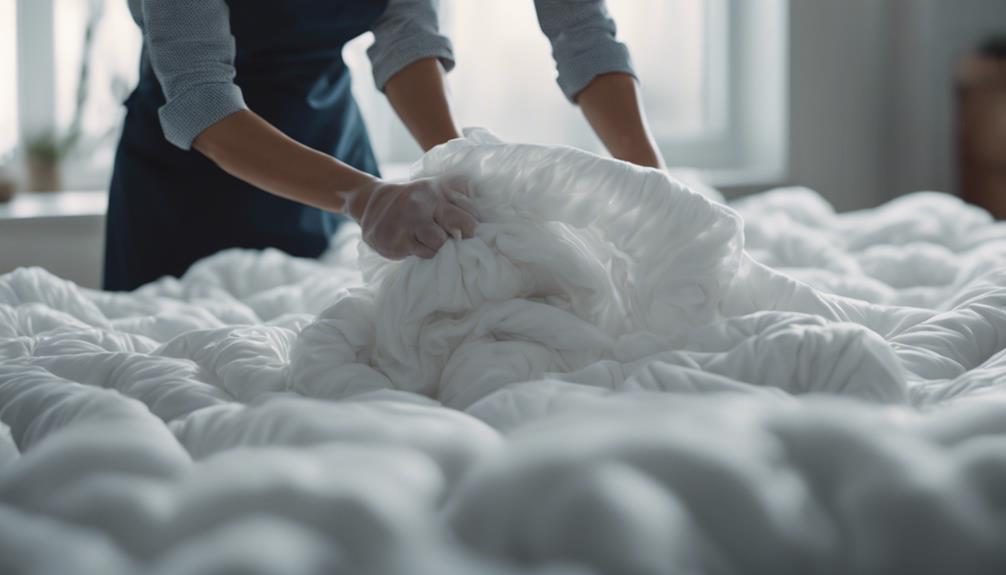
At a dry cleaning establishment, we have the capability to thoroughly clean a comforter utilizing a specialized process. This professional laundering procedure includes inspection, pretreatment for any stains, cleaning in solvent tanks using safe solvents, and meticulous drying to ensure the fabric’s quality is maintained. This technique is particularly suitable for delicate fabrics such as wool, silk, cashmere, or down comforters. Dry cleaning helps preserve the colors, prevents shrinking, and retains the comforter’s original shape. By choosing this method, you are ensuring a thorough clean that promotes a healthier sleeping environment. Entrusting experts to handle the cleaning process can extend the lifespan of your comforter.
Key Takeaways
- Dry cleaners can effectively launder comforters using safe solvents.
- Dry cleaning preserves comforter colors, shape, and fit.
- Specialized dry cleaning process includes inspection, pretreatment, and specific drying.
- Machine washing may damage delicate fabrics like wool, silk, or down.
- Follow care label instructions for proper maintenance and longevity.
Dry Cleaning Process for Comforters
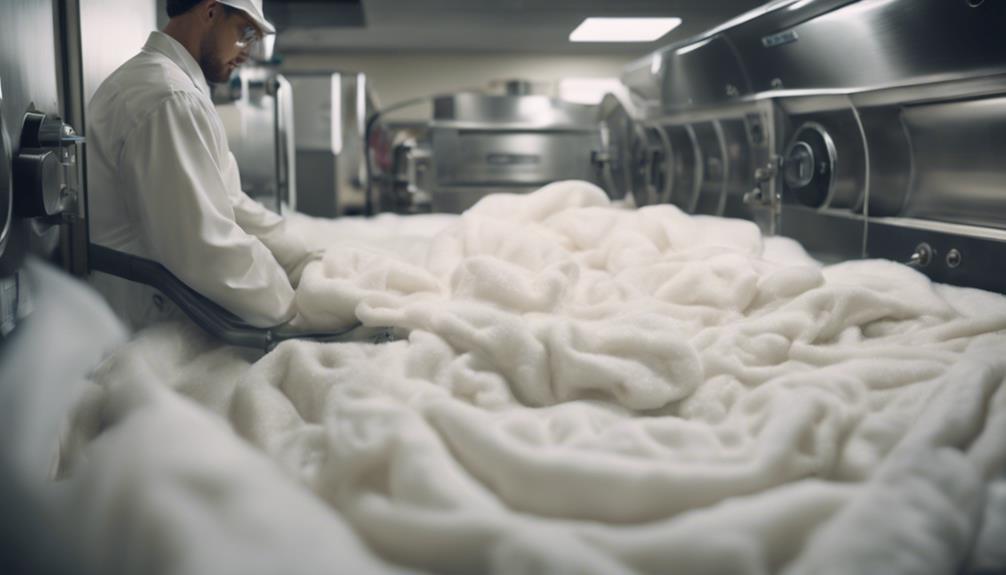
Dry cleaners typically handle comforters by following a professional laundering process that involves thorough inspection and treatment before cleaning in a solvent tank. The examination is vital to identify any stains or damages that require special attention during the cleaning process.
After inspection, any stains or heavily soiled areas are pretreated to guarantee effective removal. Comforters are then placed in a solvent tank where they're gently cleaned using safe solvents that are suitable for different fabric types. Drying temperatures are carefully monitored to prevent damage to the comforter and ensure proper drying. Once dry, the comforter undergoes finishing touches to make it look fresh and neat.
It's important to note that not all dry cleaners have the washing capabilities to handle comforters, so it's advisable to inquire about their specific services beforehand. The cost of dry cleaning a comforter can vary depending on factors such as size and material, typically ranging between $30 to $50.
Benefits of Dry Cleaning Comforters
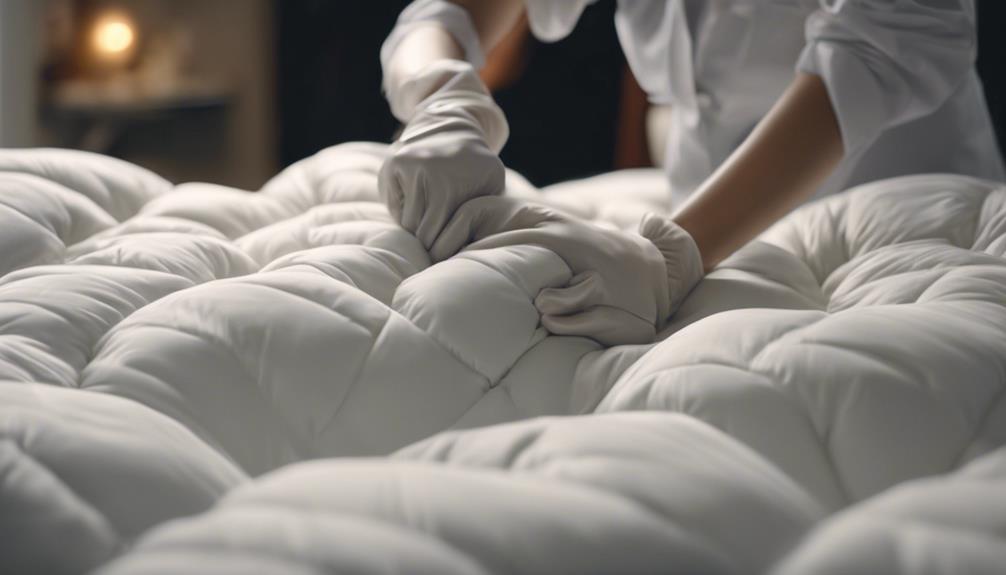
Regular dry cleaning of comforters offers several advantages beyond just cleanliness and convenience. By opting for dry cleaning for your comforter, you not only guarantee a thorough and deep clean but also enjoy a range of benefits that contribute to the longevity and quality of your bedding. Let's explore some key advantages of choosing dry cleaning over washing your comforter at home:
| Benefits of Dry Cleaning Comforters | |||
|---|---|---|---|
| Protects Colors | Preserves Shape | Prevents Shrinking | Deep Clean |
| Dry cleaning safeguards the vibrant colors of your comforter, preventing fading even after multiple cleanings. | Dry cleaning helps maintain the original shape of your comforter, preventing lumps and twists that can occur in a washing machine. | It averts shrinking, ensuring your comforter continues to fit properly and provide warmth. | Dry cleaning effectively removes dust mites, skin cells, and oil for a deep clean, promoting a healthier sleeping environment. |
These benefits collectively contribute to not only cleanliness but also the overall quality and comfort of your beloved comforter.
Machine Washing Vs. Dry Cleaning Comforters
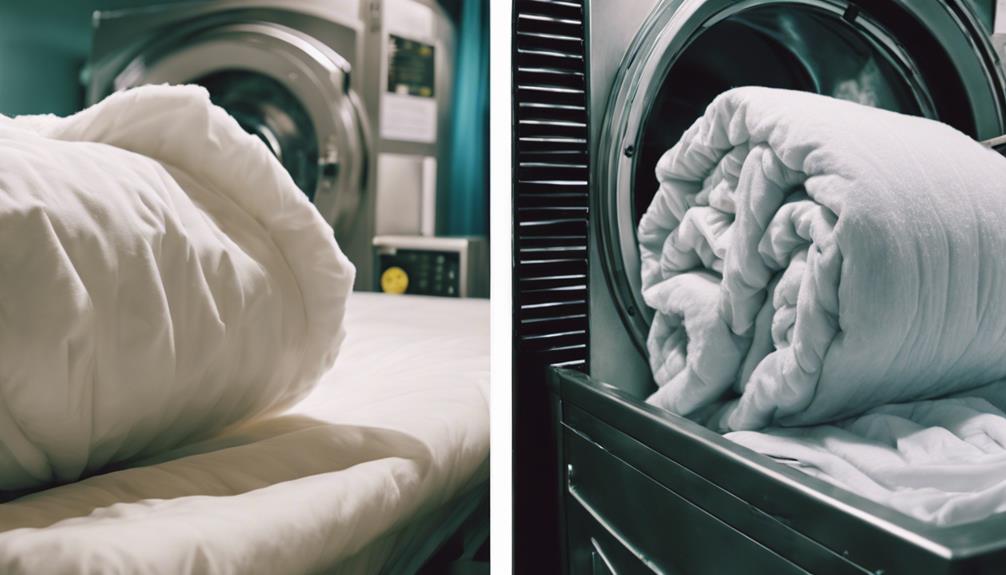
When considering the best method for cleaning your comforter, it's important to weigh the advantages and differences between machine washing and dry cleaning.
Dry cleaning is recommended for delicate materials like wool, silk, cashmere, or down comforters. The process includes inspection, pretreatment, cleaning in a solvent tank, drying at specific temperatures, and finishing, taking about 3-4 hours. It utilizes chemical solvents that are gentle on fabrics.
On the other hand, machine washing can potentially damage certain fibers in comforters and should only be done if permitted by the care label. If machine washing is suitable, use a delicate cycle with cold or warm water and low heat for drying.
Understanding the care requirements of your comforter is important in deciding between dry cleaning and machine washing to maintain the longevity and quality of your bedding.
Proper Care for Down Comforters
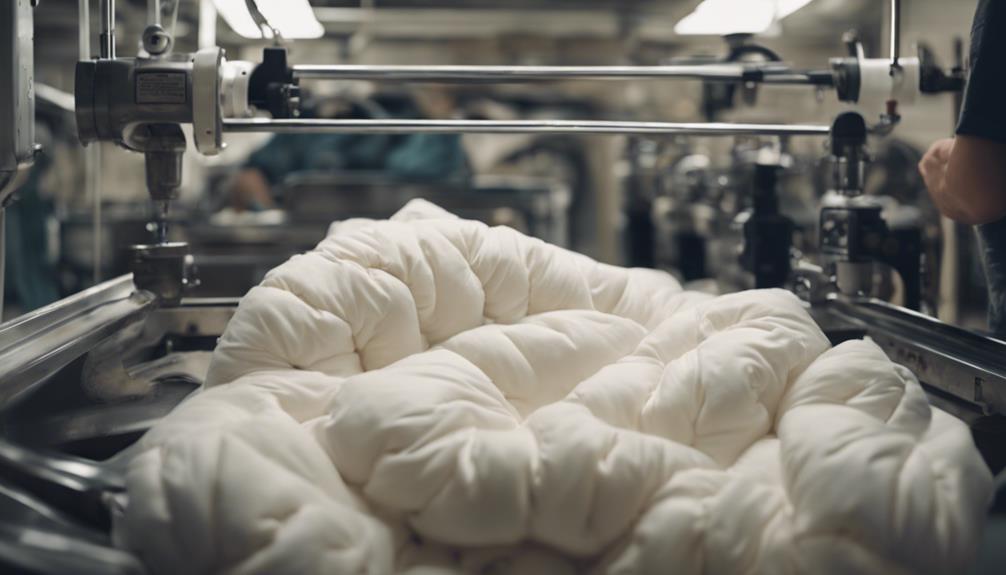
Taking proper care of down comforters is essential to guarantee their longevity and quality. To make sure your down comforter stays in top condition, consider the following care tips:
- Professional laundering: Opt for professional laundering over dry cleaning to avoid damage from harsh chemicals.
- Duvet cover: Use a duvet cover to reduce the frequency of washing your down comforter, helping to maintain its cleanliness.
- At-home washing: If you choose to wash your comforter at home, make sure you have a full-sized washing machine to properly clean and maintain it.
- Spot cleaning: For stains, spot cleaning is recommended to extend the time between full washings and preserve the quality of the bedding.
- Follow care instructions: Always refer to the care instructions provided with your down comforter to ensure you're washing it correctly and maintaining its quality.
How to Wash Dry-Clean-Only Comforters

To maintain the quality and appearance of dry-clean-only comforters, it's essential to utilize specialized cleaning methods provided by professional dry cleaners. When it comes to washing these delicate fabrics, dry cleaning is the recommended method. Following the care label instructions is vital to make sure the comforter is treated properly and to avoid any potential damage during the cleaning process.
Professional dry cleaners use gentle solvents that are safe for delicate fabrics, providing a thorough and safe cleaning process. These solvents are effective in removing tough stains and odors from comforters without compromising their integrity. By entrusting your dry-clean-only comforter to a professional, you can rest assured that it will be cleaned thoroughly and returned to you in pristine condition.
Frequently Asked Questions
How Much Does It Cost to Wash a Comforter?
Washing a comforter at a dry cleaner typically costs between $30 to $50. The price can vary based on factors like size and material. Opting for professional laundering over dry cleaning is often recommended for comforters.
Most dry cleaners offer this service, making it convenient for customers. Dry cleaning a comforter helps preserve its quality and cleanliness effectively.
Should a Down Comforter Be Washed or Dry Cleaned?
We recommend washing a down comforter instead of dry cleaning it to avoid harsh chemicals that can damage the down. Most dry cleaners can launder down comforters for $30 to $50, depending on size.
Using a duvet cover can help protect the comforter and reduce the frequency of washing. For washing at home, use a large machine or a laundromat, ensuring even balance.
Regular fluffing is essential to maintain the comforter's loft.
Is Dry Cleaning a Comforter Expensive?
Dry cleaning a comforter can vary in cost, typically ranging between $30 to $50. Factors like size, material, and location influence the price.
While dry cleaning is an option, it may not always be the most cost-effective method. Professional laundering is often recommended over dry cleaning, especially for down comforters that can be damaged by harsh chemicals.
Considering alternatives based on cost and material sensitivity is essential when deciding how to clean a comforter.
Where Can I Wash a Large Comforter?
When it comes to washing a large comforter, opting for a professional cleaner is a wise choice. Not all places can handle the size, so it's important to inquire beforehand.
Most dry cleaners provide laundering services for comforters, with prices varying between $30 to $50. It's recommended to choose professional laundering over dry cleaning to preserve the comforter's quality.
Always make sure the cleaner offers comforter services before bringing in your bulky bedding.
Should I Take My Comforter to a Dry Cleaner or Can I Wash It Myself?
If your comforter is labeled as dry clean only, it’s recommended to take it to professional dry cleaners for comforters. This will ensure that it is properly cleaned without risking damage. However, if it’s machine washable, follow the care instructions on the label for best results.
Conclusion
To sum up, when contemplating whether dry cleaners can wash comforters, it's crucial to take into account the type of comforter and its care instructions. Dry cleaning provides advantages such as safeguarding delicate fabrics and preserving the quality of down comforters.
Nonetheless, if your comforter is labeled as dry-clean-only, it's advisable to adhere to those instructions to prevent harm to the fabric. Always prioritize the longevity and quality of your comforter by selecting the appropriate cleaning method.
Comforter
Can You Wash a Velvet Comforter
Nurture your velvet comforter's luxurious texture by learning the best washing methods to preserve its softness and beauty.
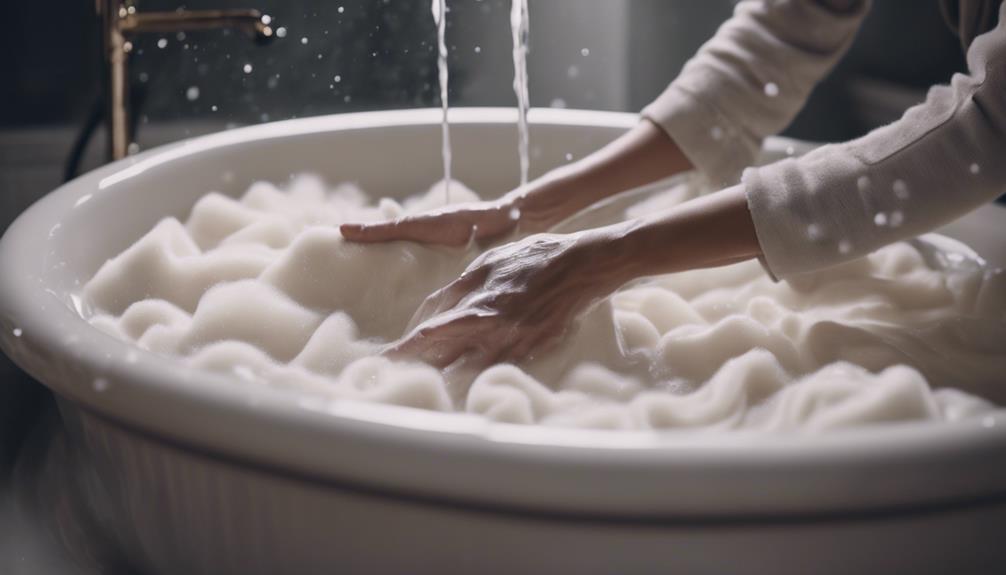
For **velvet comforters**, it is ideal to use **dry cleaning** to avoid harm, but **machine washing** is an option if done delicately. Use cold water and **gentle cycle** settings, mild detergent without fabric softeners, and steer clear of bleach. Use a large-capacity washer to avoid overcrowding. For drying, hang on a clothesline or low heat in a tumble dryer. For a luxurious feel, opt for **dry cleaning**. Treat with caution and spot clean stains to preserve softness. Learn more about caring for **velvet comforters**. Interested in maintaining your velvet comforter in top condition?
Key Takeaways
- Dry cleaning is recommended for velvet comforters to prevent damage.
- Machine wash on cold, gentle cycle with mild detergent.
- Air-dry or tumble dry on low heat to maintain fabric integrity.
- Spot clean stains and avoid harsh chemicals like bleach.
- Follow care label instructions for proper maintenance.
Velvet Comforter Washing Instructions

When caring for velvet comforters, dry cleaning is recommended to maintain their quality and prevent damage. Velvet is a delicate fabric that can be easily damaged by water, making traditional washing methods unsuitable.
Spot cleaning is a vital way to address small stains without risking water damage. For lightly soiled comforters, a home dry cleaning kit can be a convenient alternative to washing. It's essential to follow the care label instructions on the velvet comforter to make sure proper cleaning methods are employed.
Using a gentle detergent specifically designed for delicate fabrics can help in spot cleaning stains effectively. Dry cleaning is the best way to preserve the luxurious texture of velvet and prevent any potential damage that may occur during washing. By following these washing instructions, you can maintain the quality and longevity of your velvet comforter.
Machine Washing Guidelines for Velvet Comforter
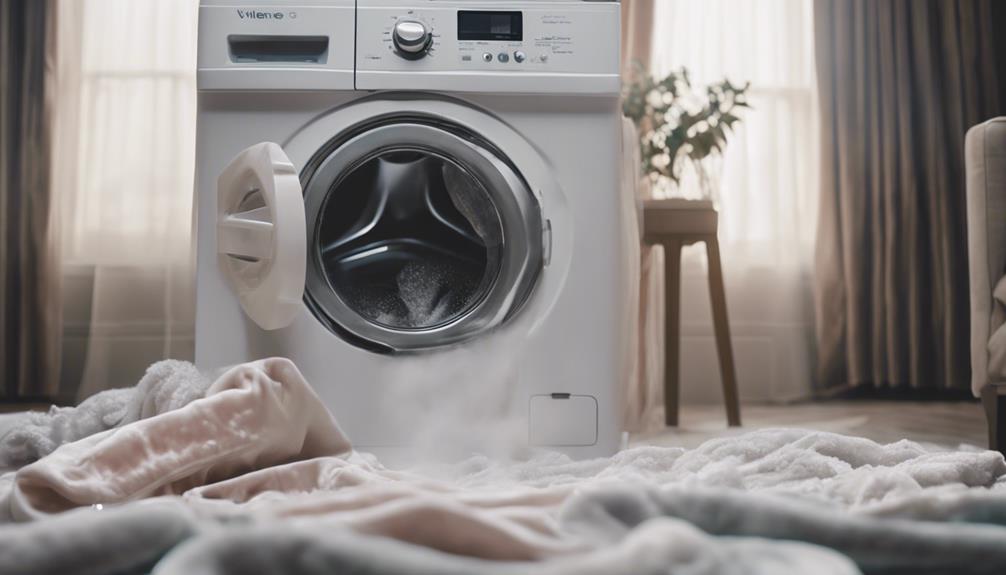
When machine washing a velvet comforter, be sure to select a cold water setting on a gentle cycle to protect the delicate fabric.
Use a mild detergent that doesn't contain fabric softeners to maintain the softness and texture of the velvet material.
Avoid bleach and harsh chemicals to preserve the color and quality of the comforter during washing.
Machine Washing Precautions
To ensure proper care for your velvet comforter during machine washing, it's important to follow specific guidelines to preserve its delicate fabric. Use a large-capacity washer to prevent overcrowding, select a gentle cycle with cold water, and avoid harsh detergents to maintain the quality of the velvet.
When drying, opt for air-drying or use a low heat setting in the tumble dryer to prevent shrinking. Consider adding wool dryer balls to help fluff the comforter and prevent excessive wrinkling.
Drying Velvet Comforters
For best preservation of your velvet comforter's delicate fabric during drying, choose to air-dry it on a clothesline or with low heat in a tumble dryer. This gentle drying method helps maintain the softness and texture of the velvet fabric.
Avoid high heat settings that could potentially damage the fabric. To prevent excessive wrinkling and help fluff the comforter, consider adding wool dryer balls during the drying process.
When washing and drying velvet comforters, use a gentle detergent without fabric softeners to preserve the quality of the fabric. Following the care label instructions is essential for ensuring the longevity of your velvet comforter.
Dry Cleaning Recommendations for Velvet Comforter
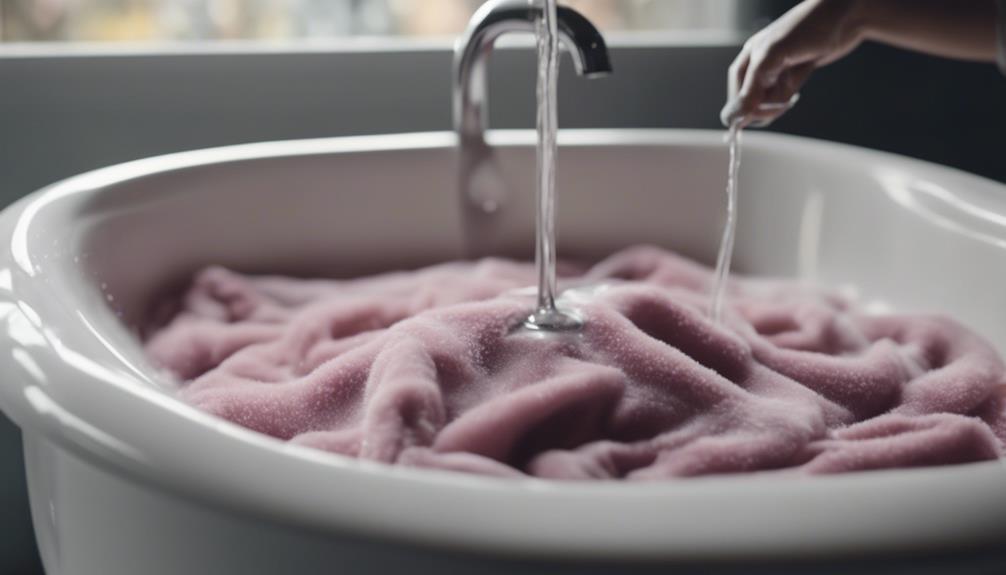
When it comes to caring for velvet comforters, dry cleaning is the recommended method for maintaining their luxurious texture and appearance. Professional dry cleaners have the expertise to handle delicate fibers and intricate designs without causing damage.
Following these velvet care tips will guarantee that your comforter stays clean, fresh, and in prime condition for a long time.
Dry Cleaning Process
How can we effectively maintain the plushness and color of a velvet comforter without risking damage or distortion?
When it comes to caring for velvet bedding, dry cleaning is highly recommended. Dry cleaning with a gentle detergent helps prevent damage, removes stains, and keeps the fabric looking luxurious. Before dry cleaning, spot clean any visible stains and make sure to read the care label for specific instructions.
Dry cleaning not only helps maintain the plushness of the velvet but also removes wrinkles, extending the lifespan of your comforter. By following proper dry cleaning recommendations for velvet bedding, you can enjoy a fresh and vibrant comforter while preserving its delicate texture.
Professional Dry Cleaners
Entrusting our velvet comforters to professional dry cleaners guarantees the delicate fabric is expertly cared for, preserving its plushness and vibrancy over time. Dry cleaners recommend dry cleaning velvet comforters to protect the delicate fabric, maintain the pile, and preserve the texture.
With their specialized equipment and professional expertise, dry cleaners can guarantee thorough cleaning without risking shrinkage or damage that may occur with water washing. By opting for professional dry cleaning, velvet comforter owners can rest assured that their luxurious bedding will be handled with care, maintaining its quality and appearance for years to come.
Professional dry cleaning is a reliable method to keep velvet comforters looking their best while extending their lifespan.
Velvet Care Tips
Choosing professional dry cleaning for your velvet comforter guarantees the delicate fabric is expertly cared for, maintaining its plushness and vibrancy over time.
When dealing with stains on velvet items, it's crucial to be gentle to prevent damage. To spot clean a stain, gently remove excess residue and then blot the area with a clean cloth. Avoid rubbing the stain, as this can push it deeper into the fabric. For tougher stains like wine, blot with an absorbent towel and consider seeking professional dry cleaning if the stain persists.
When handling velvet items, it's also advisable to brush the fabric lightly to prevent matting and maintain its soft texture. Use a gentle detergent specifically designed for delicate fabrics to ensure proper cleaning without causing harm.
Tips for Preventing Velvet Damage

To maintain the luxurious feel of your velvet comforter, it's essential to handle it with care and avoid harsh detergents or excessive heat during washing. When cleaning your velvet comforter, opt for cool water and a gentle detergent to prevent damage to the delicate fabric. Harsh detergents and bleach can harm the velvet fibers, leading to premature wear and tear. If your comforter has specific stains, it's best to spot clean them instead of subjecting the entire piece to unnecessary washing.
Consider dry cleaning your velvet comforter for a professional touch that guarantees proper care. When drying at home, use low heat settings to prevent shrinkage and maintain the integrity of the fabric. Adding wool dryer balls can help fluff the velvet fibers and reduce wrinkling during the drying process. To store your velvet comforter properly, choose a breathable container to avoid yellowing or damage from humidity. By following these tips, you can prolong the life of your velvet comforter and keep it looking luxurious for years to come.
Drying Techniques for Velvet Comforter

After discussing tips for preventing velvet damage, let's now focus on drying techniques for velvet comforters.
To guarantee the longevity and quality of your velvet comforter, it's vital to follow proper drying methods. When air-drying a velvet comforter, lay it flat or hang it to prevent stretching or distortion of the fabric. If using a tumble dryer, opt for a low heat setting to dry the comforter gently without damaging the delicate fibers. To help fluff the velvet comforter and avoid excessive wrinkling, consider adding wool dryer balls to the dryer.
When drying a velvet comforter, it's essential to avoid direct sunlight as it can cause color fading and impact the fabric's luxurious appearance. Always refer to the care label instructions for specific drying recommendations tailored to your comforter. By using gentle detergent, following the correct drying techniques, and taking precautions to prevent color fading, you can maintain the fabric quality and prevent color fading of your velvet comforter.
Maintaining Velvet Softness After Washing

To maintain the softness of your velvet comforter after washing, consider utilizing a clothes steamer to lift matted fibers and eliminate wrinkles effectively.
Gently brush the velvet comforter with a soft brush to restore its plush and luxurious feel.
When drying, avoid high heat settings in the dryer to prevent damaging the delicate velvet fibers. Instead, use wool dryer balls to fluff the comforter during the drying process, helping to preserve its softness.
After washing, store the velvet comforter properly in a breathable container to prevent crushing and maintain its soft texture.
Remember to be gentle with velvet fabrics, as they require special care to retain their softness and smooth appearance.
Final Tips for Velvet Comforter Care
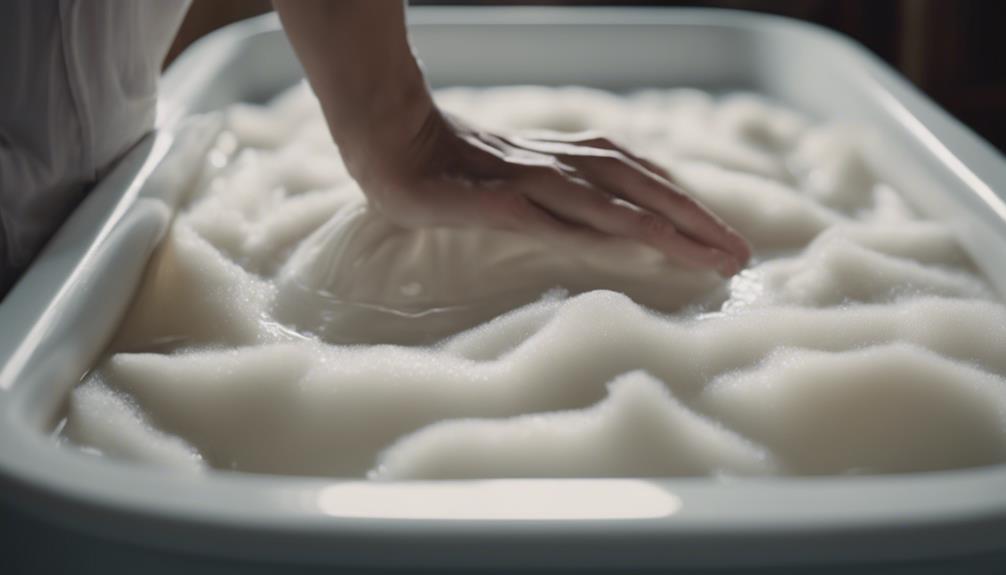
For best care of your velvet comforter, consider incorporating these final tips. Always check the care tag to determine the best cleaning method. If your comforter requires dry cleaning only due to delicate materials like natural silk, opt for professional cleaning to protect the delicate pile.
When washing at home, use a gentle detergent without added harsh chemicals and wash in cold water to maintain the fabric's softness. Never use harsh detergents or high heat, as they can damage the velvet fibers. Spot treat any stains before washing to guarantee a thorough clean.
To freshen velvet comforters between washes, spot cleaning is recommended. After washing, air dry the comforter flat to maintain its shape and soft texture. By following these best practices, you can keep velvet comforters looking and feeling their best for years to come.
Frequently Asked Questions
Can I Put Velvet in the Dryer?
Yes, we don't recommend putting velvet in the dryer. High heat can damage the delicate fabric, causing shrinkage and matting.
It's best to air dry or use a low heat setting to preserve the velvet's quality. To prevent misshaping, lay the velvet flat or hang it for drying. Avoid wringing or twisting the fabric.
Following these steps will help maintain your velvet comforter's integrity and keep it looking its best.
Is Velvet Machine Washable?
Is velvet machine washable?
It depends on the type of velvet. Pure velvet comforters are best dry cleaned to preserve the delicate fabric.
However, polyester or crushed velvet comforters can often be machine washed in cold water on a gentle cycle.
Always follow the care instructions on the label for best results. Using a mesh washing bag can help prevent damage to the fabric during machine washing.
How Do You Wash Velvet Without Ruining It?
To wash velvet without ruining it, use a gentle detergent and cold water. Avoid machine-washing to prevent fabric damage. Spot treat stains before washing, and air dry flat or hang to prevent stretching.
For delicate or heavily soiled velvet, consider professional dry cleaning. Maintaining fabric integrity is key. Follow these steps to keep your velvet looking its best.
Is Velvet Good for a Comforter?
Velvet is an excellent choice for a comforter due to its luxurious feel and soft texture. It adds elegance and warmth to any bedding ensemble.
The plushness of velvet creates a cozy and inviting experience, making it a popular fabric for comforters. Its blend of materials like cotton, polyester, or silk guarantees durability and comfort.
Proper care is vital to maintain the softness and appearance of a velvet comforter.
Is it Safe to Wash a Velvet Comforter in a Front Loader?
Yes, it is safe to consider washing comforter in front loader. While velvet can be delicate, using a gentle cycle with mild detergent and cold water can help maintain its softness and avoid damage. Just be sure to check the manufacturer’s care instructions before proceeding.
Conclusion
To sum up, washing a velvet comforter can be done successfully with the right care and technique. Remember to follow the washing instructions carefully, whether using a machine or opting for dry cleaning.
Taking preventive measures to avoid damage, using proper drying techniques, and maintaining softness post-wash are key to preserving the quality of your velvet comforter.
As the saying goes, 'an ounce of prevention is worth a pound of cure.' Keep your velvet comforter looking and feeling its best with these tips.
Comforter
Why Is My Comforter Crunchy After Washing
Find out why your comforter feels crunchy after washing and how to prevent it for ultimate coziness.

If your comforter feels crunchy after washing, it may be because of excess detergent leaving residue on the fibers. The stiff sensation is a result of soap buildup, which can make it less comfortable. To prevent this stiffness, make sure to rinse the comforter properly. Also, clumping of the fill material due to improper care can lead to discomfort. Furthermore, fiber breakdown over time can also contribute to the crunchy texture. Follow the care label instructions, use gentle detergent, and air dry when possible to maintain softness. Including tennis or wool dryer balls can help prevent crunchiness. Learn more about how to keep your comforter cozy by identifying the causes of crunchiness.
Key Takeaways
- Excessive detergent leads to residue buildup and stiffness.
- Inadequate rinsing causes soap accumulation and crunchiness.
- Clumping of fill material results in uncomfortable texture.
- Fiber breakdown from harsh care practices leads to crunchiness.
- Proper care with gentle detergent and correct drying methods maintains softness.
Excessive Detergent Usage

When we use too much detergent while washing our comforters, it can leave behind residue that causes a crunchy texture. This excessive detergent usage leads to residue buildup on the fibers, resulting in a stiff and rough feel to the comforter.
The soap residue not only affects the softness of the fabric but also hardens it over time, impacting the overall comfort of our bedding. Additionally, overloading the washing machine with detergent can prevent proper rinsing, leaving a film residue on the comforter that contributes to its crunchy texture post-wash.
To avoid this issue, it's important to follow the recommended detergent measurement indicated on the product label. Properly measuring the detergent and refraining from overpouring will help maintain the comforter's softness and prevent the unwanted crunchy sensation.
Inadequate Rinsing Process

Improperly rinsing a comforter after washing can result in detergent residue accumulating in the fibers, contributing to its stiff and crunchy texture. Inadequate rinsing can leave behind soap buildup, leading to stiffness and a less-than-fluffy texture.
When the comforter isn't rinsed properly, the residual detergent can cause the fabric to feel rough and unpleasant. To avoid this issue, it's vital to guarantee a thorough rinsing process to eliminate all detergent residue. Proper rinsing is essential for maintaining the softness and fluffiness of the comforter.
By taking the time to rinse the comforter adequately, you can prevent the accumulation of detergent that causes crunchiness. Remember, a well-rinsed comforter will feel cozy and comfortable, enhancing your overall sleeping experience.
Clumping of Fill Material
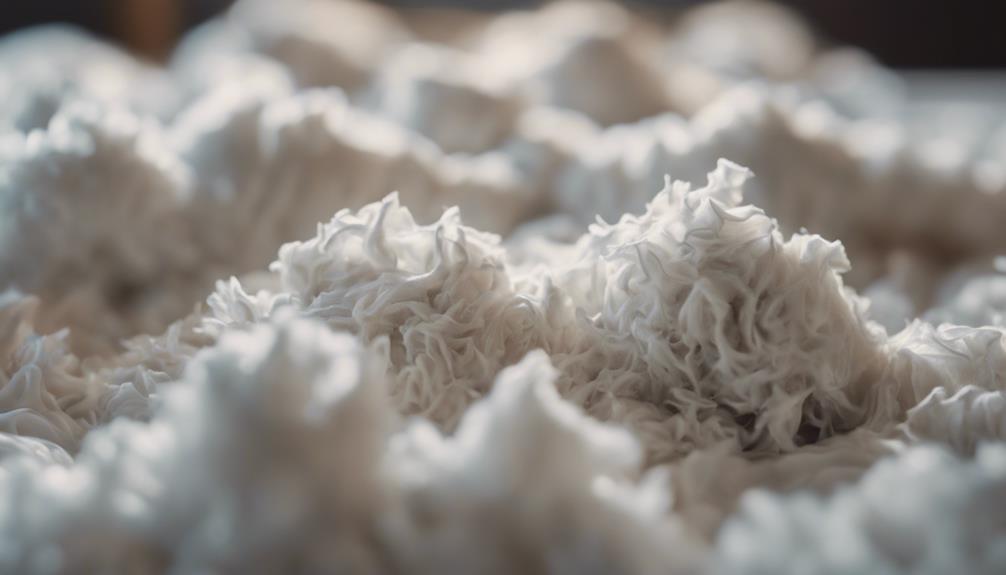
The clumping of fill material in a comforter can lead to a crunchy texture if not addressed properly. When the fill material isn't evenly distributed or if inadequate drying methods are used, clumping can occur, resulting in an uncomfortable feel to the comforter. To prevent this issue, it's essential to follow proper care and drying techniques.
- Ensure Even Distribution: Make sure the fill material is evenly spread out in the comforter before placing it in the dryer to prevent clumping.
- Use Proper Drying Techniques: Employ suitable drying techniques such as using dryer balls or periodically fluffing the comforter during the drying cycle to maintain the fluffiness of the fill material.
- Avoid Improper Care: Refrain from using high heat settings or insufficient agitation, as these practices can contribute to the fill material clumping together and creating a crunchy texture in the comforter.
Fiber Breakdown Over Time
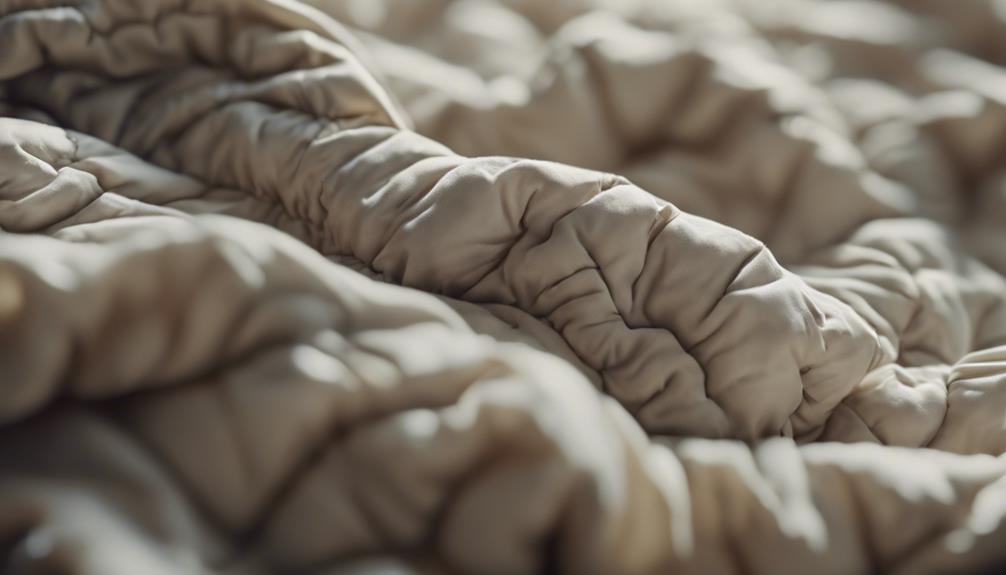
As comforters age, the fibers gradually break down, leading to a crunchy texture that can be attributed to repeated washing and drying cycles. The continuous exposure to the agitation and heat in the dryer can cause the comforter fill to break down over time, resulting in a stiff and crunchy feel. Harsh detergents used during washing can also contribute to this fiber breakdown, making the comforter lose its softness and become less comfortable to sleep under.
In addition to washing and drying, the long-term use of a comforter can lead to fiber breakdown. The fibers within the comforter may become clumpy, and the overall texture can become less fluffy and more compact. This breakdown process can be exacerbated by high heat settings in the dryer, which can melt the comforter fill and further contribute to the crunchy texture.
To avoid this issue, it's essential to consider using gentle detergents, lower heat settings in the dryer, and regular maintenance of your comforter to prolong its lifespan and preserve its softness.
Proper Care and Maintenance
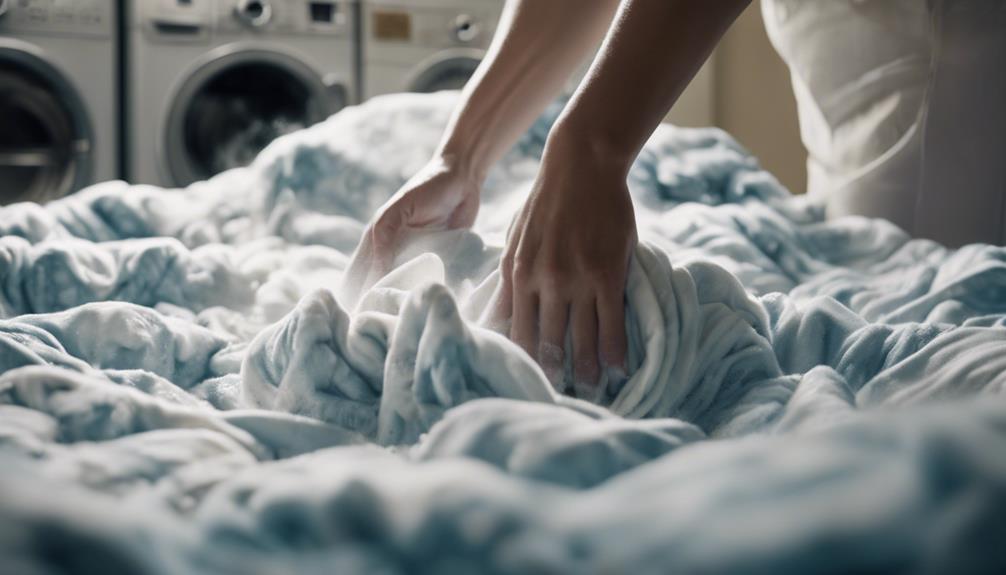
For best comforter care and maintenance, follow the care label instructions provided for washing and drying techniques. When washing your comforter, use a gentle detergent to avoid damaging the fabric and causing it to become crunchy. Avoid overloading the washing machine, as this can lead to clumping and uneven cleaning.
To guarantee your comforter stays soft and fluffy after washing, consider air drying it whenever possible. High heat in the dryer can damage the fibers and contribute to the crunchy texture. If you do use a dryer, add tennis balls or wool dryer balls to help fluff up the comforter and prevent it from becoming crunchy.
Additionally, using fabric softener or dryer sheets can help maintain the softness of your comforter and provide a more comfortable sleeping experience. By following these care and maintenance tips, you can keep your comforter clean, soft, and free of that unwanted crunchiness.
Frequently Asked Questions
How to Fix a Crunchy Comforter?
To fix a crunchy comforter, shake it while drying to prevent clumping. Use less detergent to avoid residue buildup causing stiffness. Refresh wool dryer balls for softness. Consider air drying or using a lower heat setting.
Soak the comforter in a vinegar and water solution to soften the fabric. These steps can help maintain the comforter's fluffiness and prevent crunchiness after washing.
How to Soften a Crunchy Comforter?
To soften a crunchy comforter, try using white vinegar in the rinse cycle for fabric softening. Adding tennis balls or dryer balls to the dryer can fluff up the comforter and reduce stiffness. Opt for a gentle drying setting with low heat to prevent crunchiness.
Consider using fabric softener or dryer sheets for a softer touch. Air drying the comforter outdoors can also help restore softness and remove any remaining stiffness.
Why Are My Blankets Crunchy After Washing?
Blankets can become crunchy after washing due to various factors such as detergent residue, hard water minerals, over-drying, or excessive fabric softener use.
The accumulation of soap and minerals can make blankets stiff and uncomfortable. Overloading the machines may prevent proper rinsing or drying, leading to crunchiness.
To prevent this issue, avoid high heat settings, use dryer balls, and consider re-washing with less detergent or vinegar to restore softness.
Why Did the Stuffing in My Comforter Get Hard?
When the stuffing in your comforter becomes hard, it's often due to over-drying in the dryer. Excessive heat can cause the filling material to clump together and harden. This issue can arise from using high heat settings or leaving the comforter in the dryer for too long.
To prevent crunchy stuffing, follow care instructions, use gentle drying methods, and avoid overheating in the dryer. Proper care can help maintain the fluffiness of your comforter.
Why Does a Down Comforter Become Crunchy After Washing?
After washing, a down comforter sounds crunchy due to the feathers clumping together. Improper drying or inadequate fluffing can cause the feathers to stick, creating a stiff and crunchy texture. To avoid this, ensure the comforter is completely dry and fluff regularly during the drying process.
Conclusion
To sum up, it's crucial to follow proper care and maintenance instructions when washing your comforter to prevent it from becoming crunchy. By avoiding excessive detergent usage, ensuring thorough rinsing, preventing clumping of fill material, and being mindful of fiber breakdown over time, you can maintain the softness and comfort of your bedding.
Remember, just like a delicate flower needs gentle care to bloom beautifully, your comforter needs gentle handling to stay soft and cozy.
Comforter
Why Is My Comforter Stiff After Washing
Lacking softness? Discover why your comforter feels stiff after washing and learn how to restore its fluffiness with expert tips.

If your comforter feels stiff after washing, it may be because of improper drying methods. To keep it soft, avoid high heat settings, opt for gentle cycles, and don’t overload the dryer. Clumped filling can also cause stiffness. Try using tennis or dryer balls to break up the clumps. Following care label instructions is crucial; use the correct detergent and air dry or use low heat. Ensuring proper airflow during drying is important. For more tips on maintaining your comforter’s softness and preventing stiffness, explore further guidance on drying techniques and fluffiness maintenance.
Key Takeaways
- Use low heat settings to prevent stiffness and fabric damage.
- Avoid overloading the dryer for proper air circulation.
- Regularly fluff and redistribute filling to maintain softness.
- Opt for gentle heat settings and proper drying techniques.
- Follow care label instructions for specific fabric care guidance.
Incorrect Drying Techniques

When drying your comforter, we must avoid high heat settings in the dryer to prevent stiffness and maintain its softness. Excessive heat can damage the fabric and strip it of its natural softness. It's important to select a gentle heat setting to make sure that the comforter dries evenly and remains fluffy.
Furthermore, overloading the dryer can hinder proper air circulation, leading to a stiff comforter. To prevent this, make sure the comforter has enough space to move around freely in the dryer. Additionally, using fabric softeners sparingly is advisable, as an excess of these products can leave a residue on the comforter, causing stiffness.
After washing your comforter in the washing machine, be mindful of the drying process. Opt for a low heat setting and consider using dryer balls to help fluff the comforter as it dries. By following these tips and avoiding common mistakes, you can maintain the softness and quality of your comforter for longer periods.
Clumped Filling

When clumped filling occurs in a comforter, the inner materials stick together, causing stiffness and discomfort.
To address this issue, it's essential to focus on proper filling distribution and drying techniques.
Filling Distribution
During the washing and drying process, clumped filling in a comforter can result from the bunching up of the filling material, causing stiffness and discomfort. Uneven distribution of the filling can lead to areas with excess filling and other spots with little to no filling, affecting the overall comfort and warmth of the comforter.
To prevent clumped filling, add a couple of tennis balls or dryer balls to the dryer to help break up the clumps. You can also shake the comforter periodically during the drying cycle. For maintenance, consider adding a small amount of baking soda to the comforter when washing to help loosen any clumps that may have formed over time. Regularly fluffing and redistributing the filling can also help maintain the softness and comfort of the comforter.
Proper Drying Techniques
To prevent clumped filling in your comforter and maintain its softness, using proper drying techniques is essential. Improper drying methods, like high heat settings, can cause the filling to clump together, resulting in a stiff comforter.
To avoid this, consider using dryer balls or clean tennis balls during the drying cycle to help fluff up the filling and prevent clumping, ultimately leading to a softer feel. Opting for air drying or using a low heat setting in the dryer can also help preserve the loftiness of the filling and prevent stiffness.
Remember to gently shake out the comforter during drying to evenly redistribute the filling and prevent it from clumping.
Additionally, avoid overloading the dryer with too many items, as this can compress the filling and make the comforter feel stiff after washing.
Care Label Instructions

By adhering to the care label instructions provided on your comforter, you can guarantee proper washing and drying techniques to maintain its softness and prevent stiffness. Different fabrics and fillings may have specific care requirements to make sure they stay soft after washing.
It's essential to select the right detergent and avoid washing in high heat, as these can contribute to stiffness. Air drying or using a low heat setting in the dryer can help preserve the comforter's softness.
Overloading the washer or dryer should be avoided to ensure thorough cleaning and prevent stiffness from setting in. Care labels offer valuable guidance on how to care for your comforter properly, so be sure to read and follow them diligently.
Proper Dryer Settings

When drying your comforter, remember to select a low heat setting to maintain its softness. High heat can damage the fibers, causing stiffness.
Opting for a gentle cycle and using dryer balls can also help prevent stiffness.
Heat Level Selection
Using the appropriate heat level setting on your dryer can help prevent your comforter from becoming stiff after washing. To maintain the softness of your comforter, it's recommended to use a low heat setting.
High heat settings can damage the fibers, causing the fabric to lose its original texture and comfort. Be cautious not to over-dry your comforter, as excessive heat can lead to stiffness and reduce its overall softness.
Timed Drying Options
To prevent stiffness in your comforter, consider setting the dryer to a low heat or air fluff option. Timed drying options allow you to control the drying duration, reducing the risk of the comforter becoming stiff.
Avoid over-drying, as this can strip the comforter of its softness. Additionally, using dryer balls or clean tennis balls in the dryer can help fluff up the comforter during the drying process, maintaining its plushness.
Always refer to the care label on the comforter for specific drying instructions to prevent stiffness. By following these tips and utilizing timed drying options, you can keep your comforter soft and cozy after each wash.
Use of Tennis Balls

In our quest to maintain the softness and fluffiness of our comforters, incorporating tennis balls into the drying process proves to be a practical and effective solution. Here are some reasons why using tennis balls can help improve the outcome of washing your comforter:
- Fluffing and Redistribution: Tennis balls can help fluff and redistribute the filling in a comforter during the drying process, preventing clumping and maintaining a lofty feel.
- Prevention of Clumping: The bouncing motion of tennis balls in the dryer can prevent clumping and stiffness in the comforter, ensuring an even dry and fluffy result.
- Cost-Effective Solution: Using tennis balls is a cost-effective and easy way to maintain the softness and loft of a comforter without the need for expensive dryer balls or other products.
- Cleanliness Consideration: Make sure to use clean tennis balls to avoid transferring dirt or residue onto the bedding, ensuring a hygienic drying process for your comforter.
Avoid Overloading Dryer

When drying your comforter, make sure the dryer isn't overloaded to prevent stiffness caused by uneven drying. Overloading the dryer can lead to issues such as clumping and stiffness in the comforter because proper air circulation is hindered.
To prevent stiffness, it's important to allow enough space in the dryer for the comforter to move freely during the drying cycle. By reducing the load in the dryer and avoiding overcrowding, you can help maintain the fluffiness and softness of your comforter after washing.
Properly spacing out items in the dryer is essential to ensure even drying and to prevent stiffness from setting in. Remember, a well-aired comforter is a comfortable comforter, so give it the space it needs in the dryer to avoid stiffness and maintain its cozy feel.
Proper Airflow Importance

Proper airflow during the drying process is essential for maintaining the softness of your comforter. Without adequate airflow, moisture can become trapped, leading to stiffness in the fabric.
To prevent this, make sure your comforter has access to good ventilation either by hanging it outside or using a dryer with proper airflow mechanisms.
Airflow and Drying
Ensuring sufficient airflow during the drying process is essential to prevent a comforter from stiffening after washing. Here are four key points to take into account:
- Promotes Even Drying: Adequate airflow helps the comforter dry evenly, preventing certain areas from becoming stiff while others remain damp.
- Prevents Dampness: Insufficient airflow can lead to pockets of dampness in the comforter, which contribute to stiffness as it dries.
- Retains Softness: Hanging the comforter outside or using a well-ventilated dryer promotes airflow, helping the comforter maintain its soft and fluffy texture.
- Avoids Moisture Trapping: Lack of airflow can trap moisture within the comforter fibers, resulting in stiffness and discomfort.
Preventing Moisture Buildup
To maintain a soft and comfortable feel in your comforter after washing, it is essential to prevent moisture buildup by ensuring proper airflow during the drying process. Proper airflow helps to dry the comforter thoroughly, preventing dampness that can lead to stiffness and discomfort. Lack of ventilation can trap moisture in the fibers, causing the comforter to feel stiff. To promote airflow, consider hanging the comforter outside on a clothesline or using a drying rack. Additionally, storing the comforter in a well-ventilated area post-wash can also help maintain its softness. Adequate ventilation in the laundry space is vital for preventing stiffness and ensuring your comforter stays cozy and inviting.
| Importance of Proper Airflow |
|---|
| Prevents Moisture Buildup |
| Promotes Thorough Drying |
| Maintains Softness |
Fluffiness Maintenance Tips

For fluffiness maintenance, tossing a couple of tennis balls or wool dryer balls in with your comforter during drying can help restore its softness and prevent stiffness.
Here are some additional tips to maintain the fluffiness of your comforter:
- Use Low Heat Setting: Opt for a low heat setting when drying your comforter with dryer balls to prevent overheating and potential damage to the fabric fibers.
- Shake Before Drying: Before placing the comforter in the dryer, shake it out to guarantee even distribution and prevent clumping, which can lead to stiffness.
- Avoid Overloading: To allow the comforter to move freely and regain its fluffiness, avoid overloading the dryer with too many items that may restrict movement.
- Regular Fluffing: Periodically remove the comforter from the dryer and fluff it by hand to maintain its loftiness and prevent it from becoming flat or stiff over time.
Tennis Balls Vs. Dryer Balls

When comparing tennis balls to dryer balls for maintaining the fluffiness of your comforter, consider the differences in noise levels and fabric gentleness.
Tennis balls are commonly used to help fluff and redistribute the filling in a comforter during the drying process. While they can be effective, they tend to create loud noises in the dryer due to their hard texture.
On the other hand, dryer balls, which are typically made of wool or plastic, work similarly to tennis balls but are designed to be gentler on fabrics. They not only reduce drying time and static but also offer a quieter laundry experience.
Dryer balls are known for being more gentle on delicate fabrics compared to the potential roughness of tennis balls. Both options can help maintain the loftiness of your comforter, but dryer balls may provide additional benefits such as a softer touch and reduced noise during the drying cycle.
Ensuring Even Drying

After discussing the benefits of using dryer balls or tennis balls for maintaining the fluffiness of your comforter, the focus now shifts to guaranteeing even drying to prevent stiffness.
To achieve best results and keep your comforter soft and cozy, follow these steps:
- Make sure to dry the comforter thoroughly to prevent stiffness. This will help eliminate any residual moisture that could lead to a stiff texture.
- Ensure the comforter is evenly distributed in the dryer for consistent drying. This will help all areas of the comforter dry evenly and prevent certain spots from becoming stiff.
- Use dryer balls or clean tennis balls to fluff the comforter during drying. These items can help maintain the fluffiness and prevent clumping, resulting in a softer comforter.
- Avoid overloading the dryer to allow proper airflow for even drying. Overloading the dryer can lead to uneven drying and potential stiffness. Shake out the comforter periodically during the drying process to prevent clumping and stiffness.
Frequently Asked Questions
How to Soften a Stiff Comforter?
To soften a stiff comforter, try adding white vinegar to the rinse cycle to break down residue. Use a tennis ball or dryer ball in the dryer to fluff it up.
Air dry outside on a sunny day to naturally soften the fabric. Toss a clean, damp washcloth in the dryer with the comforter for added moisture.
Consider using bedding-specific fabric softener for extra softness and a fresh scent.
How Do I Make My Comforter Soft Again?
To make your comforter soft again, try using fabric softener in the wash. It restores softness and helps prevent stiffness.
Use dryer balls or clean tennis balls when drying to fluff up the comforter. Air-drying also maintains softness.
Adding dryer sheets can further soften it. For even better results, toss the comforter with a damp towel in the dryer to loosen the fibers.
These methods will guarantee your comforter stays cozy and soft.
Why Did the Stuffing in My Comforter Get Hard?
When the stuffing in a comforter becomes hard after washing, it's often due to insufficient drying time, causing clumping and hardening of the filling.
Overloading the dryer or using high heat settings can lead to uneven drying and stiffness.
If there's not enough air circulation during drying, moisture can get trapped in the filling, resulting in hardness.
Avoid using harsh detergents or fabric softeners that can leave residues contributing to stiffness.
How to Fix a Crunchy Comforter?
When dealing with a crunchy comforter, consider adding tennis balls or dryer balls in the dryer to fluff and redistribute the filling evenly. Opt for a lower heat setting to maintain softness, and toss in a few clean, dry towels to help absorb excess moisture. Shake out the comforter during drying to prevent clumping.
Avoid overloading the dryer to allow free movement. These steps can help restore your comforter's plushness and prevent stiffness.
What Causes Comforters to Become Stiff and Crunchy After Washing?
After washing, a crunchy comforter can result from detergent residue. To fix this issue, consider using less detergent and adding vinegar to the rinse cycle. Additionally, using wool dryer balls or tennis balls can help fluff up the comforter during drying. Following these steps can lead to a softer outcome.
Conclusion
To sum up, ensuring your comforter maintains its softness after washing requires proper care and attention to detail.
By following the correct drying techniques, using tennis balls, and ensuring even airflow, you can keep your comforter fluffy and cozy.
Remember, taking care of your comforter is like tending to a delicate garden – with the right tools and techniques, you can enjoy its warmth and comfort for years to come.
-
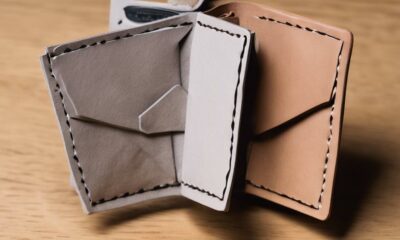
 Vetted6 months ago
Vetted6 months ago14 Best Personalized Father's Day Gifts for Your Husband – Show Him You Care
-

 Alfresco6 months ago
Alfresco6 months agoAlfresco Stacker Doors: Seamless Indoor-Outdoor Living!
-

 Vetted7 months ago
Vetted7 months ago15 Best EMS Foot Massagers for Neuropathy to Soothe Your Feet
-

 Craft and Textiles7 months ago
Craft and Textiles7 months ago15 Best Places to Buy Appliances for Your Home – Top Retailers Reviewed
-

 Tableware and Dining Accessories7 months ago
Tableware and Dining Accessories7 months agoWhat Is the Meaning of the Word Tableware
-
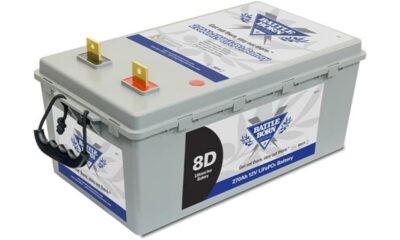
 Vetted5 months ago
Vetted5 months agoBattle Born Batteries Review: Reliable Power Solution
-

 Vetted5 months ago
Vetted5 months agoD-Link Switch Review: Lite Layer 3 Managed Networking
-

 Tableware and Dining Accessories7 months ago
Tableware and Dining Accessories7 months agoWhen Is Tableware on Sale at Hobby Lobby




























